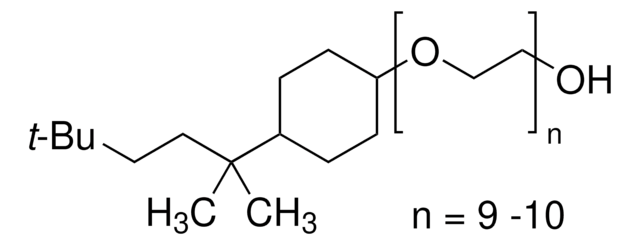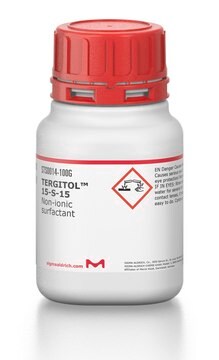X305
Triton™ X-305 solution
70% in H2O
Synonyme(s) :
Polyethylene glycol mono(4-tert-octylphenyl) ether, Polyethylene glycol p-octylphenol ether
About This Item
Produits recommandés
Description
non-ionic
Niveau de qualité
Poids mol.
~1526.0 g/mol
Concentration
70% in H2O
Technique(s)
blocking: suitable
cell culture | mammalian: suitable
hybridization: suitable
immunohistochemistry: suitable
protein purification: suitable
CMC
0.65 mM
Température de transition
cloud point >100 °C
HLB
17.3
InChI
1S/C16H26O2/c1-15(2,3)12-16(4,5)13-6-8-14(9-7-13)18-11-10-17/h6-9,17H,10-12H2,1-5H3
Clé InChI
JYCQQPHGFMYQCF-UHFFFAOYSA-N
Vous recherchez des produits similaires ? Visite Guide de comparaison des produits
Catégories apparentées
Description générale
Application
- In the treatment of cells for immunocytochemistry
- Along with peroxotungstic acid in the preparation of tungsten trioxide films by sol-gel method
- In the dispersion polymerization of styrene with activated poly(N-vinylpyrrolidone) (PVP) for the synthesis of lanthanide-encoded polystyrene particles
Informations légales
Mention d'avertissement
Danger
Mentions de danger
Conseils de prudence
Classification des risques
Acute Tox. 4 Oral - Aquatic Acute 1 - Aquatic Chronic 1 - Eye Dam. 1 - Skin Irrit. 2
Code de la classe de stockage
10 - Combustible liquids
Classe de danger pour l'eau (WGK)
WGK 2
Point d'éclair (°F)
483.8 °F - closed cup
Point d'éclair (°C)
251 °C - closed cup
Équipement de protection individuelle
Eyeshields, Faceshields, Gloves, type ABEK (EN14387) respirator filter
Faites votre choix parmi les versions les plus récentes :
Déjà en possession de ce produit ?
Retrouvez la documentation relative aux produits que vous avez récemment achetés dans la Bibliothèque de documents.
Les clients ont également consulté
Notre équipe de scientifiques dispose d'une expérience dans tous les secteurs de la recherche, notamment en sciences de la vie, science des matériaux, synthèse chimique, chromatographie, analyse et dans de nombreux autres domaines..
Contacter notre Service technique






